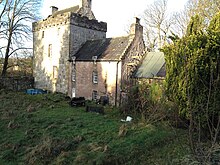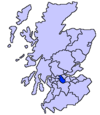캐슬카리
Castlecary| 캐슬카리 | |
|---|---|
 공중에서 본 캐슬캐리 | |
| OS 그리드 참조 | NS783779 |
| 민교구 | |
| 중위 지역 | |
| 나라 | 스코틀랜드 |
| 주권국 | 영국 |
| 포스트타운 | 글래스고 |
| 우편번호 지구 | G68 |
| 다이얼 코드 | 01324 |
| 경찰 | 스코틀랜드 |
| 불 | 스코틀랜드어 |
| 구급차 | 스코틀랜드어 |
| 영국 의회 | |
| 스코틀랜드 의회 | |
캐슬캐리(/kkːslˈkɛri/)는 스코틀랜드 노스래너크셔에 있는 작은 역사적인 마을이다.[1]이 도시는 오랫동안 기반 시설과 관련이 있으며, 다리 있는 강, 로마의 요새와 도로, 전국적인 운하, 빅토리아 시대의 철도 고가교, 그리고 현대적인 고속도로와 인접해 있습니다.Castlecary는 Cumbernauld 마을과 가깝지만 Dullatur와 Luggiebank는 공식적으로 마을의 일부가 아닙니다.1725년경 인구가 17가구에 불과한 캐슬카리의 귀족들은 팔커크 교구에서 분리되어 컴버놀드콰드 사크라로 [2]병합되었다.캐슬카리는 또한 팔커크 시의회 지역에 있지만 캐슬카리의 내화 점토 노동자들을 위해 지어진 알렌데일 근처에 있습니다.
로마의 유산
캐슬카리는 이 지역의 다른 많은 정착지들과 마찬가지로 스코틀랜드의 로마 역사에 깊이 새겨져 있다.안토닌 장벽의 경로는 마을을 통과한다.서기 80년경에, 로마 캠프가 Castlecary에 지어졌다.아그리콜라 주지사의 네 번째 선거운동 [7]기간이었을지도 모른다.성벽을 따라 있는 대부분의 로마 요새에는 약 500명의 [8]수비대가 있었다.캐슬카리와 비렌스와 같은 더 큰 요새에는 명목상 1000명의[9] 남자 코호트가 있었지만, 그 군대는 [10]결혼이 허용되지 않았지만 아마도 여자와 아이들도 보호했을 것이다.현장 [11]주변에 대규모 민간인 공동체가 있었을 가능성이 높다.1769년 포스 운하와 클라이드 운하를 위한 재료를 찾는 일꾼들이 포트 [12]남동쪽 구역에서 L자형, 하이포코스티드, 목욕탕의 잔해와 함께 8개의 아파트를 발견했다.성벽 안에서는 인골, 도자기 파편, 멧돼지 엄니 등 다른 물건들이 발견됐다.[13]역사적으로, 이 성터는 농사를 [14]짓기 위한 토지를 개선하기 위해 화약까지 사용되었기 때문에 고고학을 존중하여 다루어지지 않았다.그러나 1902년에 동정적으로 발굴되었다.

로마의 신 Fortuna를 모신 제단과 같은 [17]Castlecary에서 발견된 유물들은 이제 [18]글래스고의 Hunterian Museum에서 볼 수 있다.캐슬캐리 요새에서 11개의 새겨진 석조물이 회수되었습니다.이 중 9개는 제단이었고, 6개는 로마군 [19]부대 이름이 새겨져 있었다.1771년 캐슬카리에서 로마의 행운, 운명[21],[22] 행운의 신 포투나의 [20]사암 조각상이 발견되었다.Fortuna는 약 1000개의[23] 다른 로마 동전들에 묘사되어 있고, 그것들을 보면 [24]묘사된 것은 수성이 아니라 Fortuna라는 것에 의심의 여지가 거의 없다.제6군단이 수성에 보낸 로마 제단이 [25][26]캐슬카리에서 발견되었다.조지 맥도널드는 그의 책 [27]"스코틀랜드의 로마 장벽" 제2판에서 그것을 36호라고 부릅니다.작은 제단인데 맥도날드는 가로 20인치, 세로 10인치 정도밖에 안 된다고 합니다.그는 이탈리아인과 영국인이 로마 군대의 동지였다는 것을 보여준 것으로 그것을 주목할 만하다고 여겼다.운하를 파다가 무명의 여신에게 바치는 제단이 발견되었다.4글자 이상은 읽기 어렵다.
동전 몇 개와 로마 튜바의 잔해도 발견되었고,[33] 아이들이 있었다는 것을 암시하는 작은 신발 한 켤레도 발견되었다.스코틀랜드 국립박물관은 또한 콘우 마우스피스, 유리컵 조각, 쇠손톱 망치, 나무 주걱, 조각된 두 개의 돌도 전시하고 있다.한 개의 돌은 '안토니우스 [34]아라투스의 세기, 여섯 번째 코호트'를 나타낸다.21세기에 Castlecary에서 [35][36]사자 머리의 보물창고가 발견되었다.붉은 번, 포스, 클라이드 운하, 도로, 옛 철도역과 관련된 장소는 오래된 지도에서 [37][38]볼 수 있습니다.운하는 캐슬캐리 [40]외곽의 보니강 근처에 있는 수로를 타고 레드 번을 건넌다.[39]캐슬카리 바로 서쪽,[41] 가르널에서 두 개의 로마 임시 수용소가 발견되었다.현재는 [42]보이지 않지만 둥근 울타리와 가능한 망루도 발견되었다.톨파크에서 [43]장벽의 가장 긴 연속 구간 중 하나로 남아 있습니다.캐슬캐리와 웨스터우드 [44]요새 사이에서 발견됩니다.호텔 뒤에 있는 키스 게이트를 통해 [45]벽의 이 부분에 접근할 수 있습니다.
몇몇 고고학자들은 비록 그러한 주장들이 [46]증거가 부족하지만 캐슬카리가 프톨레마이오스의 코리아 데티오룸이라고 추정했다.데모니족이나 데모니족은 [47]프톨레마이오스에 의해서만 언급되었다.
파이어클레이 브릭웍스
캐슬캐리에는 1968년에 [48]문을 닫은 알렉산더 위어에 의해 19세기 후반에 설립된 캐슬캐리 파이어클레이 컴퍼니 리미티드(Castlecary Company Limited)와 1980년대까지 [49]존 지 스타인에 의해 설립된 스타인의 캐슬캐리 워크스(Castlecary Works) 두 개의 내화 점토 벽돌공장이 있었다.그 두 회사는 서로 멀리 떨어져 있었다.알렌데일에 있는 스타인의 벽돌공장은 1899년에[50] 문을 열었고 여러 해 동안 지역 일자리를 제공했습니다.그 부지는 현재 버려진 채 재개발을 기다리고 있다.Allandale 마을은 Castlecary 벽돌공들을 위해 지어졌고 John Stein의 사업은 세계 [51]2위의 내화 점토 벽돌 제조사로 성장했다.1932년 캐슬카리 축제일의 초기 화면은 스타인 가족이 [52]촬영한 것으로 남아 있다.다른 19세기 고용주로는 채석장과 제재소가 [53]있다.
철도역 및 기념정원
이전 벽돌공장의 사용으로 제안된 것 중 하나는 Allandale이라고 불리게 될 새로운 "파크 앤 라이드" 철도역을 건설하는 것이었다.이전에 이 역을 캐슬캐리라고 부르자는 제안이 있었지만, 서머셋에 캐슬캐리 역의 존재와 둘 사이의 혼란의 가능성을 고려할 때, 이 역의 이름을 그렇게 부르지 말자는 제안이 제안되었다.
이전에는 캐슬캐리 역이 있었지만 [56]1967년에 폐쇄되었다.1937년 12월 10일 두 열차가 충돌한 캐슬캐리 레일 참사가 일어난 곳이다.이 사고로 35명이 사망하고 179명이 [57]부상했다.2008년 [58]8월 30일 마을 현충원에 기념비가 설치되었다.1968년 9월 9일의 캐슬캐리 철도 사고도 그곳에서 기념된다.
오늘의 마을

오늘날 그 마을에는 주택 이외에는 거의 없다.캐슬캐리 하우스[59] 호텔은 마을에서 잘 알려진 사업체이며 2016년에 [60]매물로 나왔다.호텔은 M80 고속도로 서쪽과 운하 남쪽에 위치한 중심부에 위치하고 있습니다.요새와 성은 M80의 동쪽에 위치해 있어 마을의 많은 역사를 양분하고 있다.이 지역의 주요 고용주는 CMS Windows로 Castlecary에 본사를 두고 있으며 전국적으로 [61]250명 이상의 직원을 고용하고 있습니다.
Castlecary는 M80을 가로지르는 고가교에서 그 이름을 빌려주지만 공식 명칭은 Castlecary, Red Burn, Railway Viadridge 또는 Red Burn [62]Viadridge입니다.많은 사람들에게 "캐슬캐리 아치"로 알려진 이 랜드마크는 1842년에 [63]개통된 에든버러와 글래스고 철도를 위해 지어졌다.A80이 개통되기 전에 이 도로는 하나의 [64]아치로 되어 있었다.
인접한 포스 운하와 클라이드 운하, 보니 워터와 함께, 이 고가교는 Castlecary의 등각선으로서의 지위를 물리적으로 나타내는 역할을 합니다.왜냐하면 이 근처는 Cumbernauld 주변에서 사용되는 웨스트 센트럴 스코틀랜드 억양과 뚜렷한 변화가 있기 때문입니다.인근 보니브릿지와 데니에서 사용되는 언어입니다.남동쪽으로 약 24km 떨어진 하틸은 고속도로를 따라 있는 또 다른 장소로 방언과 지방 당국 간의 변화를 나타내는 것으로 인식된다.
캐슬카리 초등학교는 1973년에서 [66]1976년 사이에[65] 폐교되었다.제2차 세계 대전 일지 중 학교에서 발췌한 것이 남아서 이용할 수중에 있습니다.[67]어린이들을 [68]위한 새로운 놀이공원이 2018년 6월에 개장했습니다.
M80 반대편에 있는 캐슬 캐리 캐슬은 리지 베일리가 [69]창문에서 뛰어내린 곳이에요
레퍼런스
- ^ "Canmore Search". Canmore. Historic Environment Scotland. Retrieved 11 October 2017.
- ^ The new statistical account of Scotland. Edinburgh and London: W. Blackwood and Sons. 1845. p. 152. Retrieved 11 October 2017.
- ^ "statuette of Fortuna". Hunterian Museum & Art Gallery Collections: GLAHM F.43. University of Glasgow. Archived from the original on 13 October 2017. Retrieved 13 October 2017.
- ^ "Gubernaculum from Dictionary of Roman Coins". Forum Ancient Coins. The Collaborative Numismatics Project. Retrieved 12 October 2017.
- ^ "Roman statuette of Fortuna". BBC - A History of the World. Retrieved 12 October 2017.
- ^ MacDonald, James (1897). Tituli Hunteriani: An Account of the Roman Stones in the Hunterian Museum, University of Glasgow. Glasgow: T. & R. Annan & Sons. pp. 90–91. Retrieved 11 October 2017.
- ^ "Castlecary Roman Fort and Castlecary Tower". CastlesFortsBattles. Retrieved 14 October 2017.
- ^ "Soldier". Frontiers of the Roman Empire. Retrieved 21 October 2017.
- ^ Miller, S. N. (1952). The Roman Occupation Of South Western Scotland Being Reports Of Excavations And Surveys Carried Out Under The Auspices Of The Glasgow Archaeological Society By John Clarke, J. M. Davidson, Anne S. Robertson, J. K. St. Joseph, Edited For The Society With An Historical Survey By S. N. Miller. Glasgow: Robert Maclehose & Company Limited. Retrieved 11 October 2017.
- ^ "Roman child's leather shoe". A History of the World. BBC. Retrieved 17 October 2017.
- ^ Rohl, Darrell, Jesse. "More than a Roman Monument: A Place-centred Approach to the Long-term History and Archaeology of the Antonine Wall" (PDF). Durham Theses. Durham University. Available at Durham E-Theses Online ref: 9458. Retrieved 14 October 2017.
- ^ Rohl, Darrell, Jesse. "More than a Roman Monument: A Place-centred Approach to the Long-term History and Archaeology of the Antonine Wall" (PDF). Durham Theses. Durham University. Available at Durham E-Theses Online ref: 9458. Retrieved 14 October 2017.
- ^ Stuart, Robert (1845). Caledonia romana: a descriptive account of the Roman antiquities of Scotland. Edinburgh: Bell and Bradfute. pp. 338–347. Retrieved 11 October 2017.
- ^ Macdonald, Sir George (1934). The Roman wall in Scotland, by Sir George Macdonald (2d ed., rev., enl., and in great part rewritten ed.). Oxford: The Clarendon press. pp. 241–252. Retrieved 11 October 2017.
- ^ "RIB 2155. Honorific Building Inscription of the First Cohort of Tungrians". Retrieved 5 May 2018.
- ^ Macdonald, Sir George (1934). The Roman wall in Scotland, by Sir George Macdonald (2d ed., rev., enl., and in great part rewritten ed.). Oxford: The Clarendon press. pp. 412–414. Retrieved 11 October 2017.
- ^ "Castlecary". The Antonine Wall. Retrieved 10 October 2017.
- ^ "The Antonine Wall: Rome's Final Frontier". The Hunterian. University of Glasgow. Retrieved 10 October 2017.
- ^ "Castlecary". Roman Britain. Archived from the original on 4 June 2018. Retrieved 28 October 2017.
- ^ "Fortuna". The Magical Art of Thalia Took. Retrieved 12 October 2017.
- ^ "Fortuna & The Wheel of Fortune". Exploratory Shakespeare. Retrieved 12 October 2017.
- ^ "Fortuna Redux". The Obscure Goddess Online Directory. Retrieved 12 October 2017.
- ^ "Fortuna Coins". Online Coins of the Roman Empire (OCRE). American Numismatic Society and the Institute for the Study of the Ancient World at New York University. Retrieved 12 October 2017.
- ^ "Late Roman Coins with Fortuna, from the period of the first tetrarchy at the end of the third century AD". Ancient Roman and Greek Coins: Educational pages. Retrieved 12 October 2017.
- ^ "altar to Mercury". National Museums Scotland. Retrieved 28 October 2017.
- ^ "Castlecary Fort" (PDF). Frontiers of the Roman Empire. Retrieved 14 October 2017.
- ^ Macdonald, Sir George (1934). The Roman wall in Scotland, by Sir George Macdonald (2d ed., rev., enl., and in great part rewritten ed.). Oxford: The Clarendon press. pp. 420–421. Retrieved 11 October 2017.
- ^ "RIB 2146. Altar dedicated to Fortuna". Roman Inscriptions of Britain. Retrieved 26 May 2018.
- ^ "altar to Fortuna by Second and Sixth Legions". Hunterian Museum & Art Gallery Collections: GLAHM F.21. University of Glasgow. Archived from the original on 13 October 2017. Retrieved 13 October 2017.
- ^ MacDonald, James (1897). Tituli Hunteriani: An Account of the Roman Stones in the Hunterian Museum, University of Glasgow. Glasgow: T. & R. Annan & Sons. pp. 73–75. Retrieved 11 October 2017.
- ^ "RIB 2148. Altar dedicated to Mercury". Roman Inscriptions of Britain. Retrieved 26 May 2018.
- ^ "RIB 2150. Altar dedicated to a goddess". Roman Inscriptions of Britain. Retrieved 26 May 2018.
- ^ "Castlecary Antonine Wall Fort". Roman Britain. Archived from the original on 4 June 2018. Retrieved 10 October 2017.
- ^ "Castlecary finds". National Museums Scotland. Retrieved 28 October 2017.
- ^ "Bronze Lion Head Mount, Castlecary". Retrieved 21 October 2017.
- ^ "In pictures: Scottish treasure trove". BBC. 29 June 2012. Retrieved 12 October 2017.
- ^ "OS 25 inch Map 1892-1949". zoomable map with Bing transparency overlay. National Library of Scotland. Retrieved 10 October 2017.
- ^ "OS 6 inch Map 1892-1960". zoomable map with Bing transparency overlay. National Library of Scotland. Retrieved 10 October 2017.
- ^ "Red Burn Aqueduct". Open Street Map. Retrieved 10 August 2016.
- ^ https://www.scotlandsplaces.gov.uk/record/nls/24816/ordnance-survey-six-inch-mile-dunbartonshire-sheet-n-xxixse/OS6Inch2nd?inline=true#map-wrapper 운하 건널목 오른쪽 지도 확대
- ^ "OS 25 inch Map 1892-1949". zoomable map with Bing transparency overlay. National Library of Scotland. Retrieved 10 October 2017.
- ^ "Garnhall". Frontiers of the Roman Empire. Retrieved 21 October 2017.
- ^ "OS 25 inch Map 1892-1949". zoomable map with Bing transparency overlay. National Library of Scotland. Retrieved 10 October 2017.
- ^ "Tollpark". Frontiers of the Roman Empire. Retrieved 21 October 2017.
- ^ "Castlecary to Westerwood". The Antonine Wall. Retrieved 21 October 2017.
- ^ Carlisle, Nicholas (1813). A topographical dictionary of Scotland, and of the islands in the British seas. Compiled from the most authentic documents, and arranged in alphabetical order. Being a continuation of the topography of the United Kingdom of Great Britain and Ireland. By Nicholas Carlisle. London: Printed for G. and W. Nicol. Retrieved 14 October 2017.
- ^ "Castlecary". Doorstep history: Local history and archaeology in Lanarkshire and beyond. Retrieved 14 October 2017.
- ^ "Castlecary Fireclay Company Limited". Scottish Brick History. Retrieved 11 October 2017.
- ^ "The life of John G Stein". Scottish Brick History. Retrieved 11 October 2017.
- ^ Barber, Stuart (29 July 2015). "The industry Falkirk district was built on". The Falkirk Herald. Retrieved 11 October 2017.
- ^ Scott, Ian (26 March 2016). "Stein's – a success story built with bricks". The Falkirk Herald. Retrieved 11 October 2017.
- ^ "Castlecary". Moving Image Archive. Retrieved 11 October 2017.
- ^ The new statistical account of Scotland. Edinburgh and London: W. Blackwood and Sons. 1845. p. 19. Retrieved 11 October 2017.
- ^ Grant, Clare (23 December 2003). "Remembering the railway casualties". Cumbernauld News. Retrieved 12 October 2017.
- ^ "Report with advice on Lottery Funding" (PDF). North Lanarkshire Council. Retrieved 12 October 2017.
- ^ "Castlecary". The Gazetteer for Scotland. Retrieved 11 October 2017.
- ^ "Village remembers its blackest day after more than 70 years". The Herald. 1 September 2008. Retrieved 11 October 2017.
- ^ "Village memorial to rail disaster". BBC. 29 August 2008. Retrieved 12 October 2017.
- ^ "Castlecary House Hotel". Retrieved 11 October 2017.
- ^ "Castlecary House Hotel is for sale". Cumbernauld News. 24 August 2016. Retrieved 11 October 2017.
- ^ "CMS Window Systems secures LDC investment to support growth plans". Scottish Financial News. 3 June 2016. Retrieved 12 October 2017.
- ^ "Castlecary, Red Burn, Railway Viaduct". British Listed Buildings. Retrieved 11 October 2017.
- ^ "Nostalgia: Hidden cost of the Castlecary Arches". Cumbernauld News. 12 July 2017. Retrieved 11 October 2017.
- ^ "From the archives". Cumbernauld News. 8 October 2011. Retrieved 11 October 2017.
- ^ "From the archives". Cumbernauld News. 16 November 2013. Retrieved 11 October 2017.
- ^ "From the archives". Cumbernauld News. 16 July 2011.
- ^ "Extracts from Castlecary Primary School log book , 1939 -1945" (PDF). Falkirk Community Trust. Archived from the original (PDF) on 12 October 2017. Retrieved 11 October 2017.
- ^ "New play area for Castlecary". Cumbernauld News. 6 June 2018. Retrieved 7 June 2018.
- ^ Baird, Rev. Hugh (1864). Castlecary and the great Roman wall: their history, remains, and traditions ... Falkirk: Charles Jeffrey. pp. 68–69. Retrieved 10 October 2017.
외부 링크
![]() 위키미디어 커먼스의 캐슬캐리 관련 미디어
위키미디어 커먼스의 캐슬캐리 관련 미디어
Castlecary Banter - Castlecary Community Councils Facebook Page - 최신 정보를 얻을 수 있습니다.https://www.facebook.com/Castlecary-banter--506689536533752 를 참조해 주세요.

















